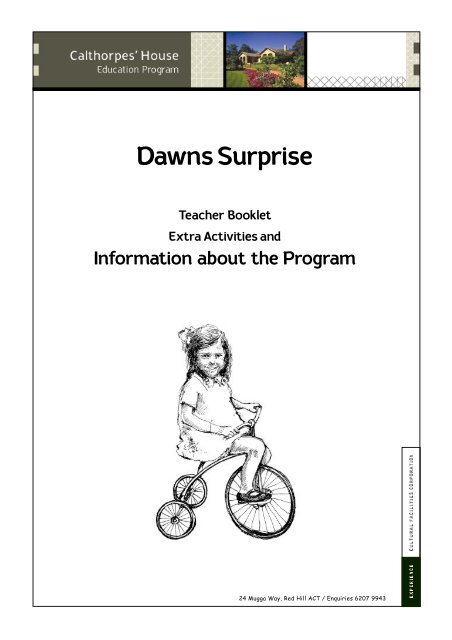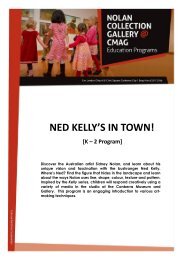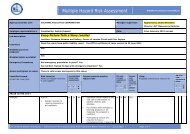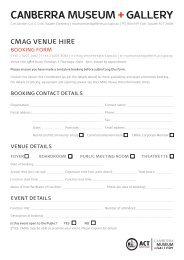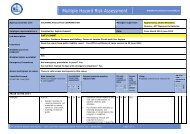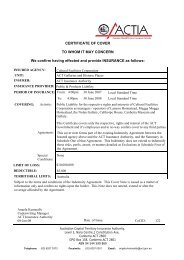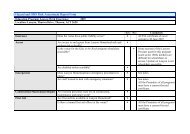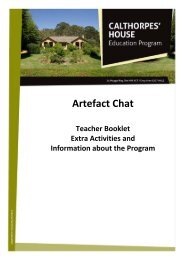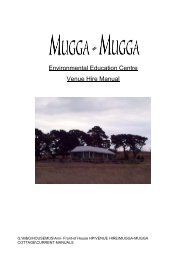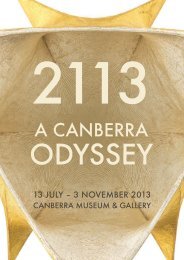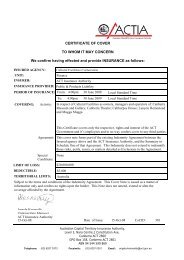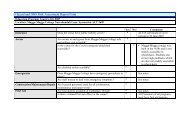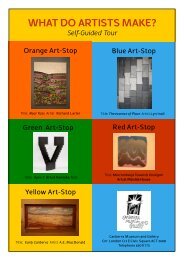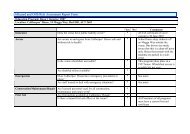Dawns Surprise - ACT Museums and Galleries - ACT Government
Dawns Surprise - ACT Museums and Galleries - ACT Government
Dawns Surprise - ACT Museums and Galleries - ACT Government
- No tags were found...
You also want an ePaper? Increase the reach of your titles
YUMPU automatically turns print PDFs into web optimized ePapers that Google loves.
<strong>Dawns</strong> <strong>Surprise</strong>Teacher BookletExtra Activities <strong>and</strong>Information about the Program24 Mugga Way, Red Hill <strong>ACT</strong> / Enquiries 6207 9943
ContentsProgram Summary p. 3Curriculum information p. 4Information about Calthorpes’ House p. 5Information about the program Dawn’s <strong>Surprise</strong> p. 6Checklist for planning your excursion p. 6What will happen during the program? p. 7Recommended pre visit activity: Dawn’s Suitcase p. 8-11Recommended post visit activity: French Knitting p. 11-12References p. 13Dawn’s <strong>Surprise</strong> bookingThank you for booking your students into the Calthorpes’ House education program,Dawn’s <strong>Surprise</strong>.Calthorpes’ House is a wonderful venue to learn about how people lived in the past. Thehouse was built in 1927 <strong>and</strong> is incredibly significant as an almost intact collection of objectsfrom the period which, with the gardens, allows students to enter a time capsule. Exploringthe house, in the footsteps of the seven year old Dawn Calthorpe, is a wonderful way forstudents to engage with how the past is different or similar to today.The programs include a tour of the house <strong>and</strong> gardens. Students will also play oldfashioned games.The following information is provided to assist teachers in making the most of their visit toCalthorpes’ House. Please note the checklist for planning your excursion is on page 6.224 Mugga Way, Red Hill <strong>ACT</strong> / Enquiries 6207 9943
Program SummaryName of ProgramTheme/sObjectives:Students will haveTarget AudienceLength of ProgramAvailability of ProgramSize of GroupCostDawn’s <strong>Surprise</strong>To provide students with an insight into Calthorpes’ Housethrough the eyes of a child – how did the seven year old DawnCalthorpe live in the 1930s?To provide students with an opportunity to learn about thelives of children in the past by comparing Dawn’s life withthe students’ own.Empathised with a seven year old from the past <strong>and</strong> beingintroduced a slice of Calthorpes’ history (1931) through theeyes of Dawn Calthorpe.Participated in an experiential, differentiated learningenvironment – discovery, h<strong>and</strong>s-on, sensory,interconnected experiences.The opportunity to compare the experiences of a real childliving in the past with their lives today.Insights into a way of family life that is clearly recognisablebut different from their daily experience.Interacted with <strong>and</strong> explored an historic site.Local studentsYears K-2 [Early Childhood b<strong>and</strong> of development]1½-2 hoursTuesday, Wednesday, Thursday30 students maximum as a single program.60 students maximum as a double program,combined with At the Garden Gate at Mugga Mugga.Maximum group size: 12 students, at least 1 adult per group$5.50 per student for single program$8.00 per student if combined as a double program withAt the Garden Gate at Mugga Mugga.Accompanying adults free324 Mugga Way, Red Hill <strong>ACT</strong> / Enquiries 6207 9943
Curriculum InformationThe program is designed for students in the Early Childhood b<strong>and</strong> of development <strong>and</strong> isframed by three Essential Learning Achievements (ELAs):1. The student uses a range of strategies to think <strong>and</strong> learn.2. The student underst<strong>and</strong>s <strong>and</strong> applies the inquiry process.21. The student underst<strong>and</strong>s about Australia <strong>and</strong> Australians. (Australian CapitalTerritory Department of Education <strong>and</strong> Training (<strong>ACT</strong>DET) 2007: 12-13).The program addresses ELA 1 <strong>and</strong> ELA 2 through the educational approach in which theprogram is undertaken. The program provides opportunities for the essential content, 1.EC.2 asstudents are encouraged to ‘ask questions <strong>and</strong> look for answers’ (<strong>ACT</strong>DET 2007: 28). One of thestrategies used in this program is experiential discovery. Students are encouraged to engagewith the site through the h<strong>and</strong>s on activities like old fashioned games.Calthorpes’ House is an ideal museum for young children to visit <strong>and</strong> experience the life of aseven year old in the past. The house museum gives insights into a way of family life whichcan be clearly recognised by your students, but which is different from their daily experience.A major focus of the program is the consideration of similarities <strong>and</strong> differences. Encouragingstudents to compare <strong>and</strong> contrast their lives with those of children from the 1930s. Theseconnections allow students to build on their own knowledge. ELA 2 requires that students‘make observations about what is happening around them using their senses’ (<strong>ACT</strong>DET 2007:34). The experiential nature of the program, closing their eyes <strong>and</strong> smelling the polish in theentrance hall, playing games <strong>and</strong> shelling peas are all allowing <strong>and</strong> encouraging students tomake those observations.ELA 21 is addressed in the program both in the opportunities to underst<strong>and</strong> <strong>and</strong> learn aboutgeographical <strong>and</strong> historical essential content. Through visiting Calthorpes’ studentsunderst<strong>and</strong> <strong>and</strong> learn about a significant place in their local community (<strong>ACT</strong>DET 2007: 204).The book, Dawn’s <strong>Surprise</strong>, creates a narrative for the house tour <strong>and</strong> provides a focus for21.EC.4 as both the book <strong>and</strong> the tour tell a story of a child’s life at a different time period,between the two wars.424 Mugga Way, Red Hill <strong>ACT</strong> / Enquiries 6207 9943
Information about Calthorpes’ HouseThe following information provides both an introduction to Calthorpes’ House <strong>and</strong> to DawnCalthorpe. This may be information you would like to share with your students inpreparation for their visit to Lanyon.Calthorpes’ House was built in 1927, the year the Provisional Parliament House opened inCanberra. Dawn Calthorpe was three years old when they moved from Queanbeyan into thebr<strong>and</strong> new house in the br<strong>and</strong> new city. Dawn lived at Calthropes’ House until she grew up<strong>and</strong> got married, during the Second World War.Dawn’s parent’s names were Harry <strong>and</strong> Del. Dawn also had a sister whose name was Del.The Calthorpe family also lived with their maid, Mary. Dawn <strong>and</strong> Del had many pets to feed<strong>and</strong> play with, the cat’s name was Tiddles, the canary was Glad, <strong>and</strong> the dog was calledJohnson.In the book, Dawn’s <strong>Surprise</strong>, it is Del’s twelfth birthday. Dawn is not quite seven. Del’sbirthday is the 29 September <strong>and</strong> Dawn’s is the 15 December. Del now lives in Queensl<strong>and</strong><strong>and</strong> Dawn still lives in Canberra.The truly unique feature of Calthorpes’ House is that everything in the house actuallybelonged to the Calthorpe family. The question of what is real <strong>and</strong> what is a reproduction isnot a factor. The connection between the story, Dawn’s <strong>Surprise</strong> <strong>and</strong> the studentsexploration of the house is immediate, for example, the pianola really is the one Del <strong>and</strong>Dawn played when they were children.524 Mugga Way, Red Hill <strong>ACT</strong> / Enquiries 6207 9943
Information about the Dawn’s <strong>Surprise</strong> programPlease Note: Dawn’s <strong>Surprise</strong> relies on the students being familiar with the book, available athttp://www.museums<strong>and</strong>galleries.act.gov.au/calthorpes/pdf/<strong>Dawns</strong>_<strong>Surprise</strong>.pdf . Pleaseread the book to your students. You are welcome to request that extra copies are send toyour school.Checklist for planning your excursionClothing: Calthropes’ House programs are indoor <strong>and</strong> outdoor excursions that involvewalking. Warm, waterproof attire is important in the cooler months <strong>and</strong> sunprotection is also a priority throughout the year. Calthorpes’ House backs onto RedHill, due to snakes long pants <strong>and</strong> closed toed shoes are required. Calthorpes’ Houseretains the right to refuse entry to students who are inadequately dressed.Weather: The programs are offered in all weather, some alternative activities can beprovided indoors. The decision to postpone lies with the school. If you do decide topostpone your booking due to inclement weather, please ring 6207 9943 <strong>and</strong>0423 828 873 as soon as possible so we can notify the presenters.Student preparation for the excursion: Discourage students from bringing backpacksas they will not be allowed to carry anything on the program. Divide the classinto smaller groups (10-12) with at least one adult for each of these smaller groups.Please ensure that every students wears a name tag. This makes it much easier forthe Presenters to communicate effectively with the students.Morning Tea <strong>and</strong>/or Lunch: Please bring everyone’s lunch in a separate box. Onarrival your presenters will show you where to put your food. There are no binsprovided, please take your rubbish away with you.First Aid Kit: Please bring your First Aid Kit.Special Needs: Please advise the bookings officer at the time of booking if there arestudents in your group with particular needs so that staff can be prepared to assist inappropriate ways <strong>and</strong> vary the program as necessary.Risk Management Plan: Please check the Risk Management Plan for Dawn’s<strong>Surprise</strong>, available from out website at the following link -http://www.museums<strong>and</strong>galleries.act.gov.au/calthorpes/education.html624 Mugga Way, Red Hill <strong>ACT</strong> / Enquiries 6207 9943
What will happen during the program?Arrival: Your bus will not be able to enter the grounds of Calthorpes’ House, as the drivewayis too narrow. Please disembark on the nature strip on the Calthorpes’ House side of thestreet (the road is quite busy <strong>and</strong> we are just below a crest, it is best that students do notcross this road). When you have disembarked, please make your way to the garage at therear of the house. You will be met by a presenter who will introduce the program to theclass.During the program: The introduction to the program will occur in the garage. After theintroduction the students will be divided into smaller groups. Each group should beaccompanied by at least one adult. The group will all do the same program in a differentorder.There are three rotations:The House:· The focus of this rotation is the book, Dawn’s <strong>Surprise</strong>. The students tend torecognise rooms <strong>and</strong> items from the book <strong>and</strong> will visit the same rooms as Dawn.· Before entering the house, students <strong>and</strong> accompanying adults will be required to putshoe covers over their shoes. This helps to protect <strong>and</strong> conserve the floor coverings.· The Presenter will wear white gloves <strong>and</strong> h<strong>and</strong>le collection items. Students willh<strong>and</strong>le one or two items from the Education Collection <strong>and</strong> it will be made clear at alltimes which items may be h<strong>and</strong>led <strong>and</strong> which may not.The Garden: The garden at Calthorpes’ House simply invites exploration. Students willbe conducted around the different sections of the garden, including the formal garden,play areas, vegetable garden <strong>and</strong> two orchards. This rotation is significant given thestrong sensory focus on smells <strong>and</strong> physical observation of the Calthropes’ garden.Games: Students will play the same games that Del <strong>and</strong> Dawn played when theywere young. These could include:o skipping;o marbles;o hopscotch;o sack races; <strong>and</strong>o egg-<strong>and</strong>-spoon races.Please note: the year of this program is 1931 – the year Dawn turned seven. Therefore, theAir Raid Shelter is not an intrinsic part of the program, as it was built about ten years later. Ifyou particularly wish your students to visit the Air Raid Shelter, please mention this whenyou make your booking, <strong>and</strong> it will be accommodated at the end of the program.724 Mugga Way, Red Hill <strong>ACT</strong> / Enquiries 6207 9943
Recommended Pre-Visit Activity: Dawn’s SuitcaseDawn’s suitcase is available free of charge to local schools. Please ring 6207 9943 toorganise your loan. Bring the suitcase back with you when you come with your class toCalthorpes’ House.Dawn’s suitcase contains objects that relate to her childhood in the late 1920s <strong>and</strong> 1930s.Unlike the collection at Calthorpes’ House these objects can be h<strong>and</strong>led <strong>and</strong> used by yourclass as they are objects from our Education Collection, representative of their time, ratherthan objects from Calthorpes’ House. They offer an excellent link to the objects your studentswill see at Calthorpes’ House.Please note: Some of the items in the suitcase are SHARP – such as the razor, hat-pins <strong>and</strong>the money box. Please supervise your students at all times.Suggestions for use:· When you first open the suitcase, ask your students to work out what all the differentitems are for. The answers range from the very easy, like the book, gloves etc to moredifficult, like the hat-pins <strong>and</strong> the soap saver.· Encourage your students to h<strong>and</strong>le the items <strong>and</strong> experiment with their use – undersupervision <strong>and</strong> as appropriate.· Discuss all the items in the context of program concept, the same, yet different.Items in the suitcase may include:Yoyo: Dawn remembers that yoyos were very popular at school. She <strong>and</strong> her friends spentmany hours practising in order to impress each other. How is this yoyo the same yet differentfrom the ones of today?Knucklebones: Knucklebones was another popular children’s game. But these are real bones.Watch out for the knucklebone next time you have a leg of lamb. How is this different fromthe knucklebones of today?Picture puzzle: While your students try to piece the different pictures together, suggest thatthey look out for a similar one in Dawn’s bedroom at Calthorpes’ House.Jig-saw: This jig-saw is typical of the ones Dawn loved as a child. How is it the same yetdifferent from the jig-saws of today?Map puzzle: This one is a copy of the original one in Dawn’s bedroom at Calthorpes’ House.What places can your students identify on the map?824 Mugga Way, Red Hill <strong>ACT</strong> / Enquiries 6207 9943
9Commonwealth Bank Money Box: There are lots of opportunities to discuss the same yetdifferent here. The Commonwealth Bank still makes similar money boxes, but with onesignificant difference. The money boxes today have a hole <strong>and</strong> a replaceable seal on thebottom, so savings can be taken out at any time. The money boxes in Dawn’s time couldonly be opened with a tin-opener (this encouraged children to be more vigilant with theirsaving). Has this one been opened? Could you re-use it as a money box?Please note: SHARP EDGES.Embroidered apron: Young girls were taught to embroider at school. Dawn remembersembroidering an apron similar to this one. It shows the kind of stitches she was required tolearn <strong>and</strong> practise.Tea infuser: Seven year old Dawn would never have heard of a tea bag. This is because teabags are quite a recent concept. How do you think tea was made with the infuser? Theinfuser was the only alternative to making a whole pot of tea for just one person.French Knitting, hair-pin <strong>and</strong> wool: This will be particularly useful if you do the post-visitFrench Knitting activity. Your students are welcome to add a few stitches – you may need toadd extra wool.Soap saver: Soap savers were used before the development of dishwashing liquid. Leftoverpieces of soap were placed inside <strong>and</strong> swished around in the washing-up water to make itsoapy. Watch out for the soap saver hanging over the kitchen sink at Calthorpes’ House.Book – Among the Horses: This is a children’s story produced in Great Britain. Note thestructure of the book: black text <strong>and</strong> pictures with occasional coloured prints. Look at thequality of the illustrations as well as what is depicted in them, e.g. clothing, changes intechnology, etc. How does it compare with the books of today?Hat-pins: Hat-pins were used to hold a woman’s hat firmly to her head. The pins wentthrough her hat to attach to her hair, <strong>and</strong> stopped it falling off when it was windy. They alsoallowed the hat to be placed at a jaunty angle without falling off. Maybe this could bedemonstrated with a school hat. How do we keep our hats on today?Please note: SHARPGloves: Women like Mrs Calthorpe would never have left the house without gloves. Theseones are made of kid, <strong>and</strong> would have been worn on special occasions. Watch out for theglove stretchers in the laundry at Calthorpes’ House.Embosser: There is an embosser just like this one in the dining room at Calthorpes’ House.The one in the suitcase actually belonged to another family, <strong>and</strong> we had the addresschanged to the Calthorpes’ address – 24 Mugga Way, Red Hill. No post code, Why not?24 Mugga Way, Red Hill <strong>ACT</strong> / Enquiries 6207 9943
Metal billy <strong>and</strong> ¼ pint measure: During Dawn’s childhood, milk was delivered by a milkmanwith a horse <strong>and</strong> cart. Dawn remembers hearing their arrival every morning as they passedher bedroom, going up the drive to deliver the milk at the back door. The milk was measuredout into the Calthorpes’ billy using a pint scoop. How do you get your milk today? How muchis a pint?School satchel: Compare it with school backpacks. How much could you carry in this one?Razor: This one is similar to Mr Calthorpe’s. How do men shave today?Please note: SHARPWriting implements for school:Dipping pen: Try writing with it. Which way up does the nib go? Why would it be difficult towrite left-h<strong>and</strong>ed?Please note: THE NIB IS SHARPPenny bottle: Ink was made up from a powder mixed with water. Once the ink had beenmixed, it would be stored in a little bottle like this one so that the dipping pen could bedipped easily.Blotting paper: Why do you need to blot the page?Box Brownie camera: Mr Calthorpe took most of the photographs in the album that isincluded in the suitcase. The Kodak Box Brownie was a popular camera of the time. How doesit compare with the way we take photographs today? This is probably the best opportunity todiscuss just how much <strong>and</strong> how fast technology is changing.1024 Mugga Way, Red Hill <strong>ACT</strong> / Enquiries 6207 9943
Photograph AlbumThis album contains photos that relate to the childhood of Del <strong>and</strong> Dawn at Calthorpes’House.1. Del <strong>and</strong> Dawn st<strong>and</strong>ing outside the br<strong>and</strong> new house in 1927. Del is eight <strong>and</strong> Dawnis three.2. Calthorpes’ House in 1927, when it was br<strong>and</strong> new. Notice that so far there is nogarden or driveway.3. Dawn on her tricycle.4. The opening of Parliament House, May 1927. The whole Calthorpes family attendedthe ceremony at the opening of Parliament House, when the Duke <strong>and</strong> Duchess ofYork opened the building.5. Building the house next door. This house was completed one year after theCalthorpes’. You can see the Calthorpes’ house in the background.6. On the steps outside the house. Dawn is sitting on the left-h<strong>and</strong> wall <strong>and</strong> hergr<strong>and</strong>mother is on the right. Del is the right-h<strong>and</strong> child sitting cross-legged on thesteps.7. This is the family car – a Buick – crossing the bridge over the Cotter River. Del isopening the door of the car.8. Del has just won the s<strong>and</strong>-castle building competition, <strong>and</strong> is sitting proudly in frontof her masterpiece. Dawn’s s<strong>and</strong>-castle is on the left.9. Del <strong>and</strong> Dawn under a sprinkler in the garden. There is lots of opportunity tocomment here on how things have changed. Do children still play under sprinklers,or are we more aware of wasting water? And look at the togs. (That’s what Del <strong>and</strong>Dawn called them. What do you call them?)10. Snow falling on the garden. How is the new garden getting on?11. Shopping at Kingston – at J. B. Young’s. Look at the interior of the shop <strong>and</strong> talk aboutthe differences between shopping then <strong>and</strong> now.Recommended post-visit activity: French KnittingOn the next page are some instructions for French Knitting. Dawn <strong>and</strong> Del were both veryfond of this activity.Suggestions:· Why not get your class busy knitting?· Or simply discuss the last paragraph of the instructions! Would you write similarinstructions today?1124 Mugga Way, Red Hill <strong>ACT</strong> / Enquiries 6207 9943
1224 Mugga Way, Red Hill <strong>ACT</strong> / Enquiries 6207 9943
References<strong>ACT</strong> Department of Education <strong>and</strong> Training. 2007. Every Change to Learn: CurriculumFramework for <strong>ACT</strong> Schools Preschool to year 10. <strong>ACT</strong> <strong>Government</strong>, Canberra.<strong>ACT</strong> Heritage Council. 20011 Calthorpes’ House Entry to the <strong>ACT</strong> Heritage Register.Downloadable from:http://www.tams.act.gov.au/__data/assets/pdf_file/0003/13359/232.pdf.Bickford, Anne. 2003. Calthorpes’ House. Cultural Facilities Corporation, Canberra.Burness, Elizabeth Pickhaver. Illustrations. Jo Pillinger, <strong>Dawns</strong> Surprize. <strong>ACT</strong> <strong>Museums</strong> <strong>and</strong><strong>Galleries</strong>. Downloadable from:http://www.museums<strong>and</strong>galleries.act.gov.au/calthorpes/pdf/<strong>Dawns</strong>_<strong>Surprise</strong>.pdfGibbney, James. 1986. Calthorpes’ Canberra The Town <strong>and</strong> Community in 1927. Calthorpes’House Museum: occasional series no. 1. Australian <strong>Government</strong> Publishing Services,Canberra.Lawson, Elaine. 1993. Calthorpes’ House Notes on the house, contents <strong>and</strong> Conservationphilosophy.Waterhouse, Dawn. 2002. Chortles, Chores <strong>and</strong> Chilblains Cameos of Childhood in Calthorpes’House, Canberra. <strong>ACT</strong> Historic Places, Cultural Facilities Corporation, Canberra.1324 Mugga Way, Red Hill <strong>ACT</strong> / Enquiries 6207 9943


